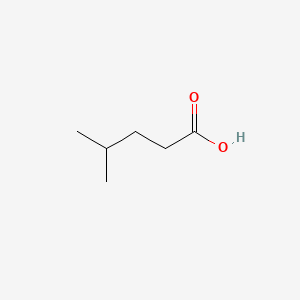| MeSH term | MeSH ID | Detail |
|---|---|---|
| Diarrhea | D003967 | 32 associated lipids |
| Diabetes Mellitus, Type 1 | D003922 | 56 associated lipids |
| Diabetes Mellitus, Type 2 | D003924 | 87 associated lipids |
| Edema | D004487 | 152 associated lipids |
| Occupational Diseases | D009784 | 42 associated lipids |
| Anemia, Sickle Cell | D000755 | 34 associated lipids |
| Clostridium Infections | D003015 | 5 associated lipids |
4-METHYLPENTANOIC ACID
4-METHYLPENTANOIC ACID is a lipid of Fatty Acyls (FA) class. The involved functions are known as CoA-transferase activity. 4-methylpentanoic acid often locates in Cytosol. The related lipids are Fatty Acids and alpha-ketocaproic acid.
Cross Reference
Introduction
To understand associated biological information of 4-METHYLPENTANOIC ACID, we collected biological information of abnormalities, associated pathways, cellular/molecular locations, biological functions, related genes/proteins, lipids and common seen animal/experimental models with organized paragraphs from literatures.
What diseases are associated with 4-METHYLPENTANOIC ACID?
There are no associated biomedical information in the current reference collection.
Possible diseases from mapped MeSH terms on references
We collected disease MeSH terms mapped to the references associated with 4-METHYLPENTANOIC ACID
PubChem Associated disorders and diseases
What pathways are associated with 4-METHYLPENTANOIC ACID
There are no associated biomedical information in the current reference collection.
PubChem Biomolecular Interactions and Pathways
Link to PubChem Biomolecular Interactions and PathwaysWhat cellular locations are associated with 4-METHYLPENTANOIC ACID?
Visualization in cellular structure
Associated locations are in red color. Not associated locations are in black.
Related references are published most in these journals:
| Location | Cross reference | Weighted score | Related literatures |
|---|
What functions are associated with 4-METHYLPENTANOIC ACID?
Related references are published most in these journals:
| Function | Cross reference | Weighted score | Related literatures |
|---|
What lipids are associated with 4-METHYLPENTANOIC ACID?
Related references are published most in these journals:
| Lipid concept | Cross reference | Weighted score | Related literatures |
|---|
What genes are associated with 4-METHYLPENTANOIC ACID?
There are no associated biomedical information in the current reference collection.
What common seen animal models are associated with 4-METHYLPENTANOIC ACID?
There are no associated biomedical information in the current reference collection.
NCBI Entrez Crosslinks
All references with 4-METHYLPENTANOIC ACID
Download all related citations| Authors | Title | Published | Journal | PubMed Link |
|---|---|---|---|---|
| Resconi VC et al. | Color, lipid oxidation, sensory quality, and aroma compounds of beef steaks displayed under different levels of oxygen in a modified atmosphere package. | 2012 | J. Food Sci. | pmid:22182210 |
| Gonda I et al. | Branched-chain and aromatic amino acid catabolism into aroma volatiles in Cucumis melo L. fruit. | 2010 | J. Exp. Bot. | pmid:20065117 |
| Bowman RA et al. | Latex particle agglutination for detecting and identifying Clostridium difficile. | 1986 | J. Clin. Pathol. | pmid:3950045 |
| Gianfrilli P et al. | Evaluation of gas-liquid chromatography for the rapid diagnosis of Clostridium difficile associated disease. | 1985 | J. Clin. Pathol. | pmid:4008667 |
| Levett PN | Detection of Clostridium difficile in faeces by direct gas liquid chromatography. | 1984 | J. Clin. Pathol. | pmid:6693575 |
| Pepersack F et al. | Use of gas-liquid chromatography as a screening test for toxigenic Clostridium difficile in diarrhoeal stools. | 1983 | J. Clin. Pathol. | pmid:6630574 |
| Buchanan AG | Selective enrichment broth culture for detection of Clostridium difficile and associated cytotoxin. | 1984 | J. Clin. Microbiol. | pmid:6746889 |
| Goto M et al. | Structural determinants for branched-chain aminotransferase isozyme-specific inhibition by the anticonvulsant drug gabapentin. | 2005 | J. Biol. Chem. | pmid:16141215 |
| Mortimore GE et al. | Multiphasic control of hepatic protein degradation by regulatory amino acids. General features and hormonal modulation. | 1987 | J. Biol. Chem. | pmid:3316218 |
| SHIMIZU K et al. | Isocaproic acid, a metabolite of 20 alpha-hydroxycholesterol. | 1960 | J. Biol. Chem. | pmid:14446007 |
